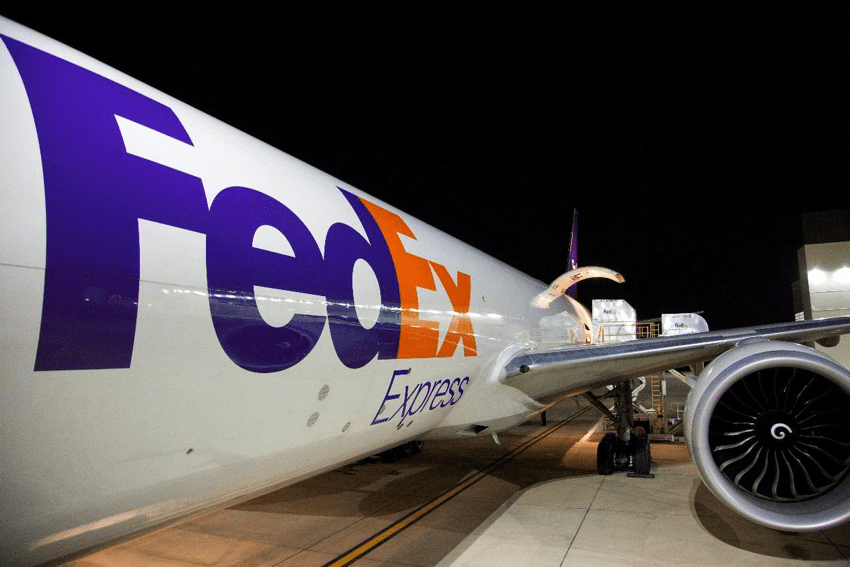
Photo:FedEx
Boeing and FedEx Express said they want to accelerate aerospace innovation, so they have agreed to collaborate on the next ecoDemonstrator.
In 2018, a FedEx Boeing 777 freighter is set to start testing emerging technologies, the companies said. Technologies include propulsion advancements and new flight deck technologies.
“The ecoDemonstrator program is focused on harvesting exciting new technologies that will benefit our airline customers, the flying public and the environment,” said Mike Sinnett, VP of Boeing Commercial Airplanes Product Development.
According to Boeing, the ecoDemonstrator program officially began in 2011. In cooperation with the FAA and American Airlines, the program flew an American Airlines next-generation 737-800 in 2012 to test 15 new technologies. The test aircraft was used, Boeing said, “to validate additional aerodynamic performance of natural laminar flow technology on the new 737 MAX Advanced Technology Winglet.” Other technologies demonstrated on the demo 737 include:
- Variable area fan nozzle
- Active engine vibration control
- Regenerative hydrogen fuel cell
- Flight trajectory optimization
- Carpet made from recycled materials
- Blended biofuel
A 787 Dreamliner, ZA004, was next in the ecoDemonstrator program. In 2014, Boeing said the company-owned aircraft was tested in partnership with the FAA’s Continuous Lower Energy, Emissions and Noise program, NASA’s Environmentally Responsible Aviation program, Japan Airlines, Delta Air Lines, Rolls Royce, Honeywell, Rockwell Collins, General Electric, Panasonic and more. The program tested, among other items:
- The ceramic matrix composite engine nozzle
- Aerodynamic and flight control improvements
- Software applications
- Connectivity solutions for flight planning, fuel-load optimization, inflight routing and landing
- NASA’s Airborne Space for Terminal Arrival Routes
- “Green diesel”
- Touchscreen displays for the flight deck
The following year, the ecoDemonstrator 757 evaluated technologies that aimed to improve efficiency and reduce noise and carbon emissions. Tests were conducted in collaboration with Europe’s TUI Group and NASA. Items like active flow control, anti-bug coatings and “green diesel” were involved, among other items.
July 2016, Boeing and Embraer unveiled their ecoDemonstrator program. An Embraer E170 was to be used as a flying testbed for technologies that might improve airplane environmental performance and accelerate their introduction into the marketplace. The ecoDemonstrator flights will test several technologies designed to reduce carbon emissions, fuel use and noise including:
- Light detection and ranging (LIDAR) technology using lasers to measure air data parameters such as true airspeed, angle of attack and outside air temperature. LIDAR shows potential to increase air data reliability by complementing current sensors, which could lead to further innovations that improve fuel efficiency and reduce carbon emissions;
- An “ice phobic” paint designed to reduce icing and help prevent accumulation of dirt and bugs due to its low adhesive property. The paint can help operators save water by reducing the need for frequent aircraft washing;
- A new wing design with improved slats to reduce noise on takeoff and approach;
- Sensors and air visualization techniques near the wing surface to better understand in-flight aerodynamics; and
- A Brazilian-produced biofuel blend made up of 10% bio-kerosene and 90% fossil kerosene, the maximum mixture according to international standards. Studies have shown that sustainably produced aviation biofuel emits 50 to 80% lower carbon emissions through its life cycle than fossil jet fuel.
This new ecoDemonstrator builds on the 38-year relationship between Boeing and FedEx. Tests for the 777 ecoDemonstrator involve installing a compact thrust reverser designed by Boeing to save fuel, flight deck improvements to improve operations in and out of busy airports and flying prototype parts that were developed with new manufacturing techniques that reduce material waste.
Boeing and FedEx said that flight testing is scheduled to last three months. The aircraft would then return to FedEx’s fleet. FedEx Express is the world’s largest airfreight carrier. A fleet of 650 aircraft carry an average of 4 million packages and 11 million pounds of freight to 375 airports in 220 countries and territories daily. According to its website, FedEx’s fleet includes the Boeing 757, 767F and 777F; the MD-10-30F and MD-11F; and the Airbus A300-600F.